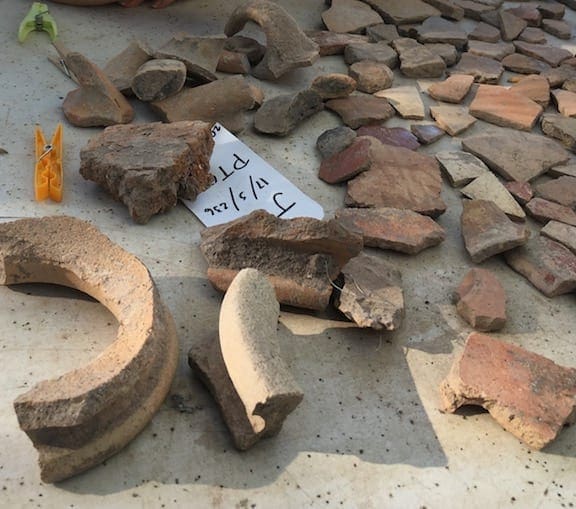Talk to anybody about your participation in an archaeological dig, and at least one question is inevitable: “What did you find?” Or, its variation: “Did you find anything good?”
No one would dig if they didn’t hope to find something, but what archaeologists look for is often quite different from popular opinion. Professional archaeologists are not out to find buried treasure or valuable objects they can sell to the highest bidder. For one thing, anything found in most countries belongs to the country, not to the expedition. For another, things that no one would give you a dollar for can be invaluable to archaeologists.

This carefully grooved stone may have been used to straighten shafts of arrows, to make beads, or for other purposes.
Why do we dig, especially in Palestine? We don’t dig in search of sensational finds, and we don’t dig to prove the Bible true (often the opposite happens). We dig because we want to know more about the past history of the land. We want to know more about the people who have lived in the land, when they were present, and what their life was like. What did they eat? When were cities built and destroyed and rebuilt? When was a particular area deserted?
These things add to our understanding of biblical stories, even if the main thing they show us is that biblical accounts were often more idealistic or agenda-laden than historically accurate in the modern Western sense of the word.

These stones, some fragmentary, appear to have been shaped by hand for various purposes, mostly grinding grain.
One of the main things archaeologists look for is stratigraphy: levels of occupation that can be dated through the types of pottery, artifacts, methods of construction, or Carbon 14 dating of organic materials such as seeds or charcoal. The foundation of a single corner of a wall may not excite the casual observer, but can be incredibly significant in tracing the remains of a building and helping to locate the floor (usually packed dirt), where the most reliably datable artifacts are located.
Susan and I were privileged to dig for two weeks with the Jezreel Expedition, co-directed by Norma Franklin of the University of Haifa and Jennie Ebeling of the University of Evansville. The ancient site of Jezreel has both an upper and a lower tel. This year we focused on two sites in the lower tel.

Pottery in this mix appears to range from the Early Bronze Age (the thicker and orange-hued pieces) to the Persian Period (the sandy-looking curved pieces in the foreground), at least.
So, what did we find? We found hundreds of pounds of pottery sherds, some of which show potential for restoration. We found thousands of pieces of flint: shaped blades, scrapers, or choppers as well as cores and chips. We found animal bones, oven materials, and blackened pieces of cooking pots. And we found lots of basalt stones clearly shaped for grinding, pounding, or other purposes: the fertile Jezreel Valley produced abundant grain.
We also found standing stones made of basalt that may have had a cultic purpose. We found walls, though most of them are in very poor shape because of past earthquakes and the site’s long history of occupation, in which new residents typically rob stones from older buildings in order to build new ones.
The current Jezreel Expedition has been at work since 2012, and has found evidence of human occupation near Ein Yizre’el (the Spring of Jezreel) stretching from Neolithic and Chalcolithic times, through the Bronze and Iron Ages, the Persian Period, the Roman Period, and on up through Byzantine, Crusader, Ottoman, and modern times.
It would be lovely to say that we uncovered conclusive remains of Jezebel’s upstairs window or a road sign pointing to Naboth’s vineyard, but such things are highly unlikely. There is one certain finding, however: we still have much to learn.





